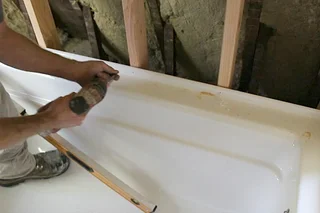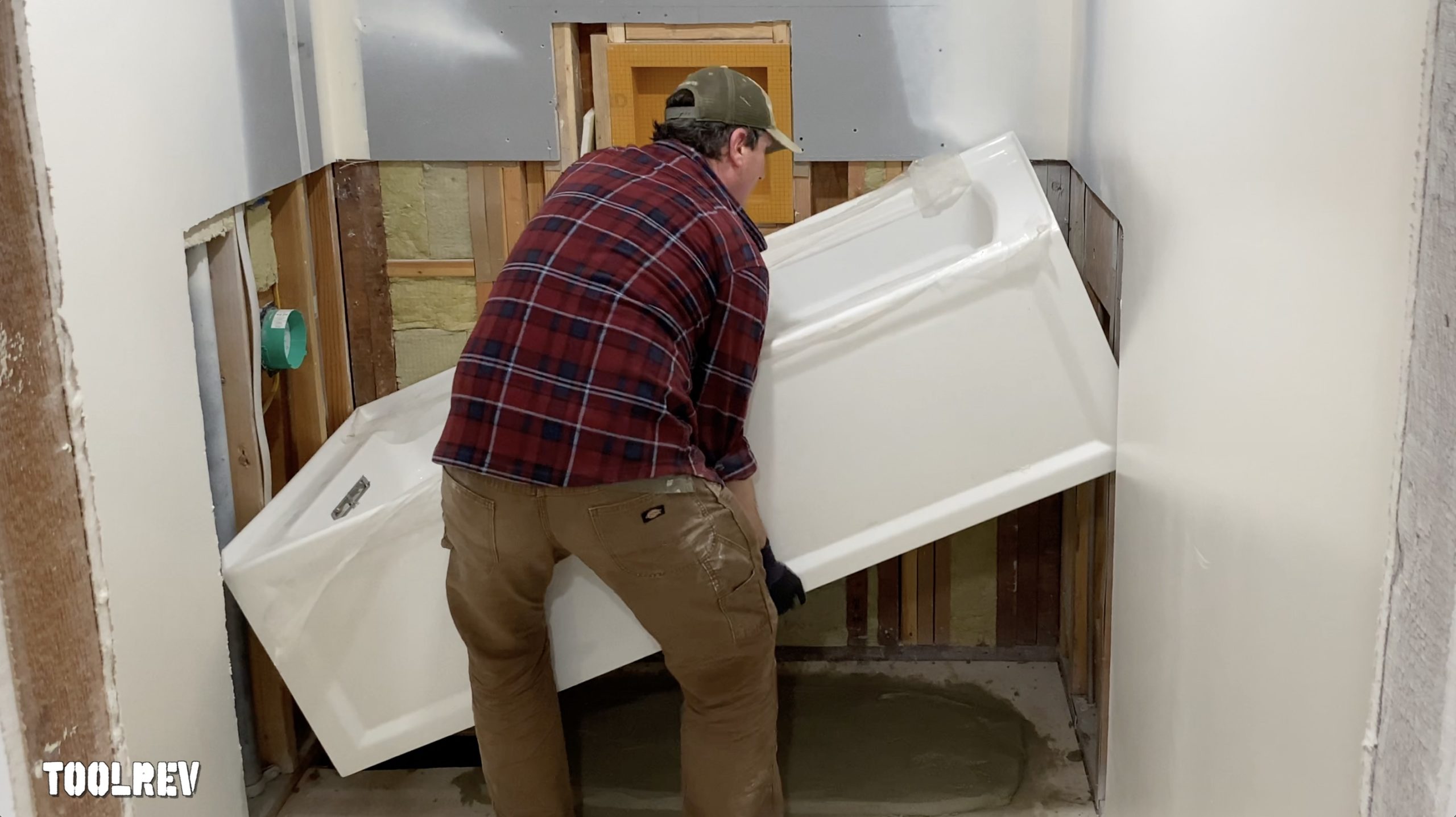We've noticed this post involving Installing A Bathtub below on the net and reckoned it made good sense to discuss it with you here.

Mounting a bath tub isn't specifically brain surgery, yet it does call for strong plumbing, woodworking, as well as sometimes, tiling skills. Replacing an old bathtub with a brand-new one is additionally a reasonably hard task. If the old bathtub is easily available, the project can move rapidly; if you have to open a wall surface to get rid of the old tub as well as position the new bathtub, the job is a lot harder. In either situation, the job is within a residence handyman's abilities, although you will certainly need a helper to move out the old bathtub and also embeded in the new one. Make sure you have actually certified yourself for the job as well as are comfortable attempting it. Rather than working with a specialist to take over a halfway-completed project, it is far better to take into consideration utilizing one before you start. Opportunities are you might require an expert plumber to make tube connections.
This article will certainly assist you install a brand-new tub in your restroom if you have currently gotten a brand-new tub and do not need to change the plan of your previous supply of water pipes.
Your devices as well as material list ought to comprise the following:
Planning for the Setup
Firstly, the sustaining frame supplied with the bathroom ought to be fitted (if required) according to the maker's instructions. Next, fit the faucets or mixer to the tub. When fitting the faucet block, it is important to make certain that if the tap includes a plastic washing machine, it is fitted between the bathroom and the faucets. On a plastic bath, it is likewise sensible to fit a supporting plate under the faucets system to stop stress on the bathtub.
Fit the versatile faucet ports to the bottom of the two faucets utilizing 2 nuts and also olives (often supplied with the bathtub). Fit the plug-hole outlet by smearing mastic filler round the sink electrical outlet hole, and afterwards pass the electrical outlet via the hole in the bath. Make use of the nut supplied by the supplier to fit the plug-hole. Analyze the plug-hole electrical outlet for an inlet on the side for the overflow pipe.
Next off, fit the end of the adaptable overflow pipe to the overflow electrical outlet. After that, screw the pipeline to the overflow face which must be fitted inside the bathroom. Ensure you utilize all of the provided washing machines.
Link the catch to the bottom of the waste outlet on the bath tub by winding the thread of the waste electrical outlet with silicone mastic or PTFE tape, and screw on the trap to the electrical outlet. Connect the bottom of the overflow tube in a comparable manner.The bath must now prepare to be fitted in its last position.
Removing Old Taps
If you require to change old taps with brand-new ones as a part of your installation, then the first thing you need to do is disconnect the water system. After doing so, switch on the faucets to drain any type of water continuing to be in the system. The process of eliminating the existing faucets can be fairly problematic because of the limited access that is typically the situation.
Make use of a container wrench (crowsfoot spanner) or a faucet tool to undo the nut that links the supply pipelines to the taps. Have a cloth prepared for the staying water that will certainly originate from the pipelines. As soon as the supply pipelines have actually been gotten rid of, make use of the very same tool to loosen the nut that holds the faucets onto the bath/basin. You will certainly require to quit the solitary faucets from transforming during this process. Once the taps have been removed, the holes in the bath/basin will need to be cleansed of any kind of old securing substance.
Prior to moving on to fit the brand-new faucets, contrast the pipeline links on the old faucets to the brand-new faucets. If the old taps are longer than the new taps, then a shank adapter is required for the new taps to fit.
Installing the Bathtub
Using both wood boards under its feet, position the bath tub in the called for position. The wooden boards are useful in evenly spreading the weight of the bathtub over the location of the boards as opposed to concentrating all the weight onto 4 tiny factors.
The next goal is to guarantee that the bath tub is leveled all round. This can be accomplished by inspecting the spirit level and adjusting the feet on the bathtub till the level checks out level.
To install taps, fit all-time low of the outermost flexible faucet port to the suitable supply pipe by making a compression join; after that do the very same for the various other tap.
Switch on the water and also inspect all joints as well as brand-new pipework for leakages as well as tighten them if necessary. Load the bath tub and also examine the overflow electrical outlet as well as the normal electrical outlet for leakages.
Lastly, fix the bath paneling as described in the supplier's user's manual. Tiling as well as sealing around the bath tub must wait until the bath tub has actually been used at least when as this will settle it into its last setting.
Suitable New Touches
If the tails of the new faucets are plastic, then you will require a plastic port to stop damages to the thread. One end of the connector fits on the plastic tail of the faucet as well as the other end supplies a connection to the current supply pipelines.
If you need to fit a monobloc, after that you will call for decreasing couplers, which connects the 10mm pipeline of the monobloc to the common 15mm supply pipe.
Next off, position the faucet in the installing opening in the bath/basin guaranteeing that the washing machines are in area between the faucet as well as the sink. Safeguard the tap in position with the producer provided backnut. When the tap is safely in place, the supply pipes can be attached to the tails of the taps. The faucets can either be linked by utilizing corrugated copper piping or with normal tap adapters. The former kind ought to be attached to the tap finishes initially, tightening up only by hand. The supply pipelines can later be attached to the other end. Tighten up both ends with a spanner after both ends have actually been connected.
Tiling Around the Tub
In the area where the bath fulfills the tile, it is needed to secure the accompanies a silicone rubber caulking. This is essential as the installation can move enough to fracture an inflexible seal, causing the water to permeate the wall surface between the bathroom and also the tiling, resulting in issues with wetness and feasible leakages to the ceiling below.
You can select from a variety of coloured sealers to assimilate your fixtures as well as installations. They are marketed in tubes and cartridges, as well as are capable of sealing voids up to a width of 3mm (1/8 inch). If you have a larger void to fill up, you can load it with spins of soaked newspaper or soft rope. Keep in mind to constantly fill the bathtub with water before securing, to permit the movement experienced when the tub is in use. The sealant can split rather very early if you do not take into account this motion before securing.
Conversely, ceramic coving or quadrant tiles can be made use of to edge the bath or shower tray. Plastic strips of coving, which are easy to use as well as cut to size, are also quickly available on the market. It is a good idea to fit the floor tiles making use of waterproof or waterproof adhesive and grout.
Bathtub Installation
How Important Is A Bathtub To Your Home?
High-quality baths, showers, and other bathroom updates are necessary when considering a smart investment in your home. It’s a room that you go to every day and one that is constantly being used by guests.The bathroom is one of the top trafficked rooms in a home and also one of the most valuable in terms of home resale.
Install Piping Before Tub
You will be using your existing drain and waste vent system, but pipes required include the hot and cold water supply lines and a pipe leading to a shower head. A mixing valve and shower head are also needed. Air chambers may be required.
Position the Tub
Lower the tub into place so that the continuous flange fits against the wall studs and rests on 1’x4' or 2’x4' supports. Anchor the tub to the enclosure with nails or screws inserted through the flanges into the studs.
NOTE: Remember, bathtubs and shower stalls may require support framing. A bathtub filled with water is extremely heavy, so check building codes and framing support before installing the tub.
Assemble Drain Connections
Assemble the bathtub drain connections by connecting the tub overflow with the tub drain above the trap, not beyond it. The trap will have a compression fitting that screws over the arm of the overflow assembly.
Place a Pipe For the Shower Head
First, locate a brass female threaded winged fitting and attach it to a framing support via a screw or a nail. Then run a pipe up the wall for the shower head. Sweat or solder the other side of the brass fitting to the top of the pipe.
Attaching Hot and Cold Water Lines
Attach your water lines for both hot and cold by sweating these directly into the hot and cold ports of the mixing valve. The mixing valve will be how water enters the tub’s system, not by the pipes themselves.
Install the Spout
Extend a piece of 1/2 inch pipe, or whichever length is specified in the manufacturer’s instructions, for the tub spout. Sweat on a male threaded fitting at the end of the pipe or use a brass nipple of the proper length and a 1/2 inch cap.
NOTE: At this point you should have your rough-in plumbing work inspected before proceeding further.
Check For Leaks
Restore the water pressure and check the drain connection and the supply pipes for any sign of leaking.
estore the Bathroom Wall
Replace the wall with moisture-resistant drywall as a base for your wall covering. Seal the joints between the wall and your new tub with silicone caulk as protection against water seepage.
https://www.berkeys.com/2016/12/02/bathtub-installation-dallas/

I was shown that write-up on How to Install a Bathtub through a friend on another blog. You should take the time to share this content if you liked it. Thanks a lot for taking the time to read it.
Book-Now